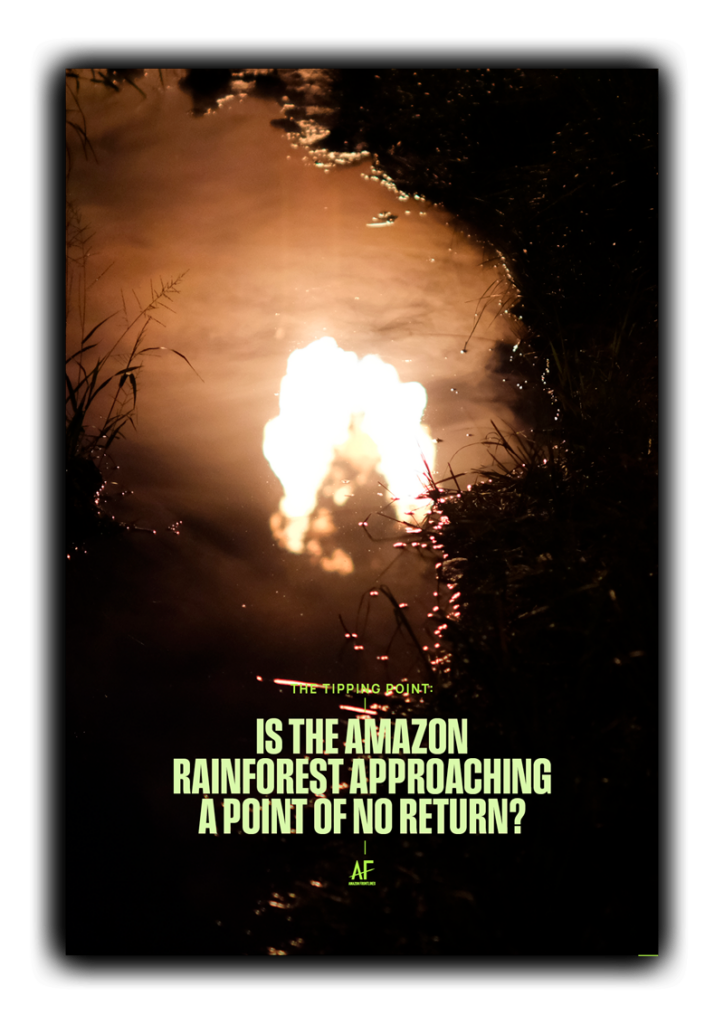Introduction

Two small rodents, the green acouchi and the Northern Amazon red squirrel, are among the most important gardeners of the Northwestern Amazon rainforest. They forage for food and bury stockpiles of fruit and nuts here and there across the forest floor, literally sowing the seeds of the forest. Or, at least, they used to. Over the past decade, they have vanished.
The summer cicadas no longer announce, with their deafening chorus of high-pitch chirps ringing from high up in the canopy, the coming turn of the season in August. The pre-spawn, underwater rattling of massive schools of “boca chico” fish have gone silent. Now, in the rivers that wind deep through the forest, hungry fishers craving their smoked egg sacks only rarely find them in scattered, sporadic, and uncoordinated clusters.
The once ubiquitous, region-wide, synchronized flower blooms and ripening of forest fruits is rare or absent altogether now. The monkeys, tapirs and peccary that depend upon these cyclical events to nourish themselves in preparation for multi-year gestation periods now raid the gardens of small Indigenous communities looking for food.
The wild beehives high up on the trunks of the giant kapok trees have become alarmingly small. Honey harvests that were once measured by the bucketful now, with luck, offer spoonfuls. Two of our dear friends explained this recently when they came for a visit bearing only a little bottle of sour honey.
These are a few examples of how ecological cycles are out of sync, in disarray, slowly and steadily being nudged out of the patterns they’ve held for millennia. These are a few of the specific, real-life shifts in the Northwestern Amazon that lie behind the global headlines about our changing climate. While teams of scientists all over the world study and discuss the coming climate tipping points, Indigenous communities across the Ecuadorian Amazon—and people like them all over the world, the people who are most connected to the earth and who are the keenest of observers—see the howler monkeys raiding their gardens, and apologize for arriving with so little forest honey to share.
Over the past decade, at Amazon Frontlines we have been working with friends and colleagues from the Waorani, Siekopai, Kofan and Siona nations. And we have listened to their stories and seen many of these changes with our own eyes as we worked on extensive Indigenous mapping projects and biodiversity monitoring.
We’ve seen the destruction of the Kofan territories wrought by decades of oil production. We’ve seen oil spills poison rivers, leach into the groundwaters and kill plants and animals for miles around. We’ve seen the devastation brought about by illegal mining and logging. And we have walked with the elders and the youth in the forest and learned how to observe some of the deeper, more subtle changes. At the same time, we’ve been reading news reports and scientific studies warning that the Amazon rainforest is approaching a tipping point.
But what exactly is a tipping point? The exact instant at which something falls over? What kinds of tipping points exist in relation to global climate change? Is the Amazon rainforest really approaching such a tipping point, and if so, what is pushing it there, and what would crossing a tipping point mean for the region? And for the planet?
Numerous scientific studies put numbers and substantial evidence to our observations of devastating change over these past 10 years. In our review of recent scientific studies, news articles, and the Global Forest Watch and MapBiomas Amazonia Project’s databases we see widespread evidence that confirms what we have been seeing on the ground and shows that the Amazon Rainforest is in fact approaching a tipping point. And it is doing so at an alarming speed. Global greenhouse gas emissions and direct deforestation in the Amazon drive this push. If both continue at current rates, the combination of longer and hotter dry seasons and less overall forest coverage could tip the entire rainforest over the edge in twelve years, or less. Scientists estimate that a 2º to 4ºC increase in average global temperatures or the deforestation of between 20% and 25% of the Amazon could trigger the tipping point; that is, endanger the survival of the entire region, transform the world’s largest rainforest into billions of tons of carbon dioxide lodged in the atmosphere and thus further accelerate global warming itself.
The greatest immediate threat to the Amazon comes from the massive fires and deforestation campaigns in Brazil, particularly in the Eastern Amazon. Between 1985 and 2022, more than seventy-one million hectares of rainforest–an area larger than Spain, Portugal and Ireland all combined–were burned or cut down in Brazil. This represents 15% of the total Brazilian Amazonian territory and 81% of the deforestation across the entire region. In comparison, Ecuador, Colombia and Peru, deforested some 4.6% of their combined Amazonian territories.
Recent studies also show something that has been obvious to us since we started working in the region: where Indigenous people control their resources, where they hold collective property rights to their lands, deforestation and carbon emission rates plummet and biodiversity and the forests thrive.
The intensely biodiverse forests at the headwaters of the Western Amazon are of particular importance to protecting our global climate. These densely forested territories absorb more carbon and release more water through transpiration. Biodiversity increases the likelihood of a forest’s overall resilience to climate-change induced heat and dryness, as there is a greater probability that non-dominant drought-resistant species will survive the heat.
Urgent action is needed regionally and globally to protect this critical biome. Greenhouse gas emissions must be cut. Deforestation must stop. Bulldozing and burning the forest to grow soybeans and graze cattle must stop. Oil and mining in the Amazon must stop. Indigenous peoples of the Amazon must be legally recognized as the owners and stewards of their lands. And then, their examples of respect and caretaking should be studied and replicated across the globe.
The tipping points are real. And they are right here, right now. Crossing them will be incalculably devastating for all life on earth.
The Idea of the Tipping Point
The phrase “tipping point” grew in popularity upon the publication in 2000 of Malcolm Gladwell’s book: The Tipping Point: How Little Things Can Make a Big Difference. Gladwell defines the tipping point as “the moment of critical mass, the threshold, the boiling point.”
Climate scientists had been discussing the dynamics of climate tipping points long before Gladwell’s book. Their phrase was less catchy: “dangerous anthropogenic interference,” which they often render even more ponderous as an acronym: DAI. The stated objective of the 1992 United Nations Framework Convention on Climate Change is to reach the “stabilization of greenhouse gas concentrations in the atmosphere at a level that would prevent dangerous anthropogenic interference with the climate system.”
Elizabeth Kolbert described the concept of dangerous anthropogenic interference in her 2006 book, Field Notes from a Catastrophe: Man, Nature, and the Climate, originally published as a series of articles in The New Yorker.
“Were the West Antarctic or the Greenland ice sheet to be destroyed,” Kolbert writes, “sea levels around the world would rise by at least fifteen feet. Were both ice sheets to disintegrate, global sea levels would rise by thirty-five feet. It could take centuries for either of the ice sheets to disappear entirely, but once disintegration got underway it would start to feed on itself, most likely becoming irreversible. Other catastrophes have similar built-in delays, which follow from the tremendous inertia of the climate system. DAI is therefore understood to refer not to the end of the process–the moment when disaster actually arrives–but to the beginning of it: the point at which its arrival becomes unavoidable,” (emphasis added).
In 2008, a team of scientists writing in the Proceedings of the National Academy of Science, defined a tipping point as, “a critical threshold at which a tiny perturbation can qualitatively alter the state or development of a system.” Some of those same authors recast their definition in the journal Science in 2022: “Here, our specific definition is as follows: Tipping points occur when change in part of the climate system becomes (i) self-perpetuating beyond (ii) a warming threshold as a result of asymmetry in the relevant feedbacks, leading to (iii) substantial and widespread Earth system impacts.”
Specific to the Amazon, in February 2024, an international team of twenty-four scientists published a paper titled, “Critical transitions in the Amazon forest system” in Nature. Here is their definition: “A ‘tipping point’ is the critical threshold value of an environmental stressing condition at which a small disturbance may cause an abrupt shift in ecosystem state, accelerated by possible feedbacks.”
Let’s consider a few ways of rephrasing these technical definitions. A tipping point signals the moment at which an on-going pressure, or series of pressures, finally overcomes resilience and initiates the fundamental transformation, or destruction, of an existing state of affairs. Or, a tipping point is the instant at which a system begins to break down due to external stressors. Or, perhaps, a tipping point announces the beginning of the end. Once it is reached, the ice will melt and flow into the oceans, the ocean currents will slow down, or stop, the forests will burn and die.
And all these disappearances—the gone glaciers, the stilled currents, the razed forests—will further increase the amount of carbon dioxide in the atmosphere, further limit the planet’s ability to absorb carbon and to reflect heat back into space, further heat up the planet, and trigger more tipping points.
Tipping Points: How they work
For decades, climate scientists and journalists have warned that the activities of human industrial civilization—specifically, those that require burning fossil fuels—are radically altering the planet’s climate, producing the overall warming of the planet, and with it, extreme weather events of all types. Longer and more severe droughts, colder winters, more devastating storms and floods, bigger tornados, stronger hurricanes, and hotter and longer summers. Human caused climate change has already set in motion such a mass destruction of life that Elizabeth Kolbert dubbed our current era as the sixth extinction.
As the planet heats up, it produces changes that release more carbon and other gasses into the atmosphere which then increase the heating of the planet. Such cycles are called feedback loops, where the impacts of a situation accelerate and strengthen the situation that caused the impacts.
Humans cut down forests. They burn some of the trees and thus both release carbon dioxide into the atmosphere as they reduce the earth’s ability to absorb carbon dioxide. Where those forests once stood, humans plant irrigated mono crops that depend on diesel pumps, or raise hundreds of thousands of cattle producing methane, they build cities and roads which they then fill with cars burning gasoline, buildings and homes that depend on coal-fired power plants, and entire industries fueled with coal, gas and oil. All these human activities release more and more greenhouse gasses into the atmosphere, which does not get reabsorbed by the felled trees.
And so, the planet heats up. And then, for example, the permafrost thaws, and as it does, the previously frozen organic matter decays and releases more carbon into the atmosphere, further heating the planet, melting glaciers, which then accelerates further melting and heats the planet, melting ice sheets which then reflect less heat back into space, further heating the planet, provoking drier conditions, worsening forest fires, which then release more carbon into the atmosphere and further heat the planet.
Combined and simultaneous feedback loops all over the planet have already led to the acceleration of geologic time. For millennia, humans believed that they could not affect the weather, though many of them would pray, dance, or sing for rain, and others later tried to build machines to make it rain. But then, over the course of some 250 years of mass deforestation and the industrial burning of coal and oil, of the unrelenting industrial release of methane, nitrous oxide and fluorinated gasses, without intending to, people changed everything.
“We changed the atmosphere, and thus we are changing the weather,” wrote Bill McKibben in the first book written for a general audience about climate change and global warming, The End of Nature, published in 1989.
In an introduction to the 2006 edition, McKibben wrote: “It is the contrast between the pace at which the physical world is changing and the pace at which the human society is reacting that constitutes the key environmental fact of our times.” As an example, he noted that: “In 1989, I said we needed to drive smaller cars and drive them less; in the intervening years, the average Americans took to piloting vehicles that would turn General Patton green with envy. We’re not getting it.”
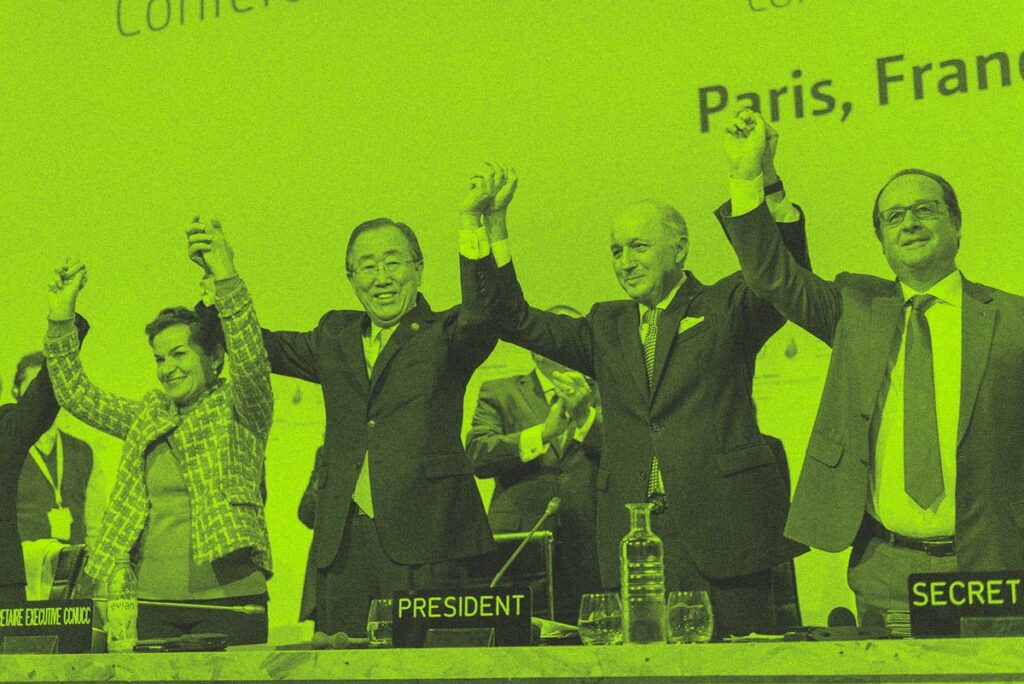
The Paris Agreement
In 1992, representatives from countries across the world drafted and signed the United Nations Framework Convention on Climate Change, a multilateral treaty establishing the basis for international climate negotiations. The treaty has been ratified by 197 countries. Five years later, in 1997, UN delegates signed the Kyoto Protocol, calling for a series of targeted reductions in greenhouse gas emissions by 2012. Most countries failed to comply and faced no tangible consequences; global carbon emissions rose by 44% between 1997 and 2012.
In 2015, UN delegates drafted and signed the Paris Agreement, which purports to be a legally binding international treaty to hold the global average temperature below 2ºC above pre-industrial levels. It was adopted by 196 Parties at the UN Climate Change Conference (COP21) in Paris, France and entered into force in November 2016.
And yet, nearly ten years later—and more than thirty years after signing the United Nations Framework Convention on Climate Change—global greenhouse gas emissions have reached an all-time high, for two years in a row. At the 2023 annual meeting of the UN Conference of Parties (COP 28), the representatives agreed on the need to “transition away” from fossil fuels; that is, after the hottest year on record, the world’s nations offered more language without commitment or action.
Wind and Ice, Coral Reefs and Forests: The Big Global Climate Change Tipping Points
Scientists talk about tipping points as those shifts in the environment that provoke radical and irreversible changes in the planet’s climate. We have already reached a 1.5 degrees Celsius rise in global temperatures over pre-industrial times. Exceeding this, scientists warn, “could trigger multiple climate tipping points.”
Carbon Brief, a UK-based, climate science website, identifies nine tipping points that could be triggered by climate change, and thus feed back into and exacerbate further global warming. Three involve melting: the Greenland ice sheet, the permafrost, and the Antarctic ice sheet. Three involve circulation changes: the West African Monsoon, the Indian Monsoon, and the Atlantic meridional overturning circulation. And three involve what scientists call biome shifts: Boreal forests shifting to tundra, coral reef die offs, and the Amazon rainforest dieback.
The 2022 Science article mentioned above also identifies nine “tipping elements.” And while their list has a few differences—it includes the El Niño Southern Oscillation, but not the coral reef die offs—the major risks are the same: melting ice, shifting air and ocean currents, and the deaths of the Amazon rainforest and boreal forests.
Hitting one, not to mention multiple global climate tipping points simultaneously, would have devastating impacts for life on earth as we know it. The authors of the 2022 Science article conclude that: “The Earth may have left a safe climate state beyond 1ºC global warming. A significant likelihood of passing multiple climate tipping points exists above ~1.5ºC, particularly in major ice sheets. Tipping point likelihood increases further in the Paris range of 1.5 to <2ºC warming. Current policies leading to ~2 to 3ºC warming are unsafe because they would likely trigger multiple climate tipping points. Our updated assessment of climate tipping points provides strong scientific support for the Paris Agreement and associated efforts to limit global warming to 1.5ºC.”
And yet, all over the world, corporations and governments are racing to clearcut and mine, to bulldoze and pave, to drill and pump and burn more than ever. And, all over the world, consumers line up to buy new cars, new cell phones, new fast fashion clothes, all products that depend on fossil fuel economies and that are designed to be replaced within a few years. As McKibben wrote in 2006, we’re not getting it. Although, this “we,” of course, isn’t actually everyone.
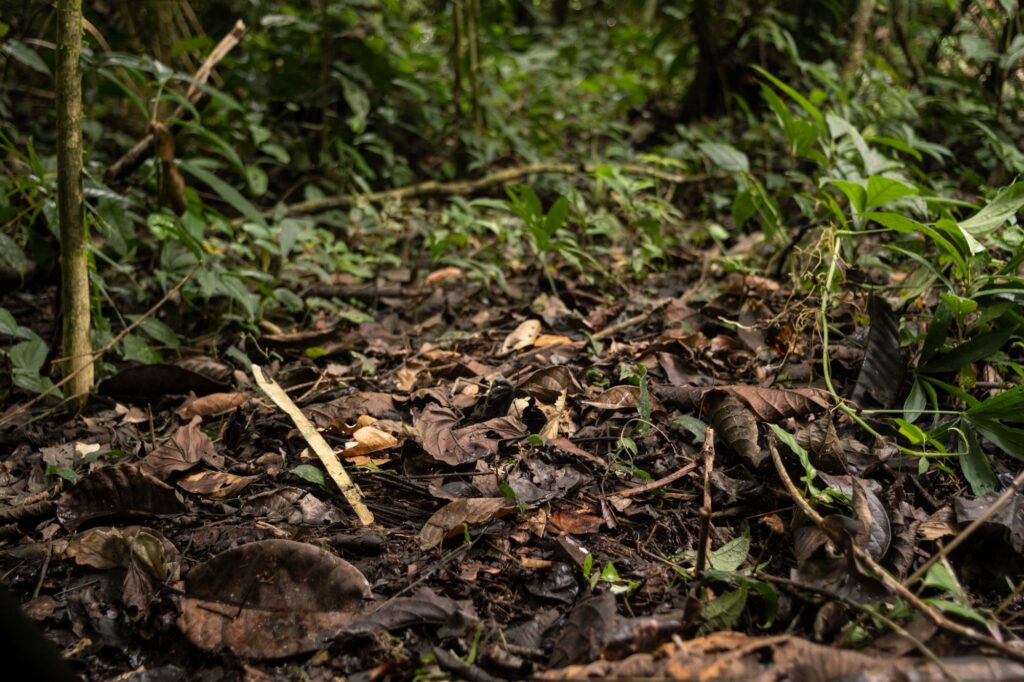
Carbon, Chainsaws, and Oil: Tipping Points for the Amazon Rainforest
Theoretically, either global warming or direct deforestation could trigger a tipping point for the Amazon. But reality surpassed theory some time ago: a combination of both climate change induced heating and direct deforestation has already pushed the Amazon to the edge. Multiple studies show that only a slight further increase in average global temperatures and/or the continued cutting and burning of portions of the forest will turn the entire Amazon rainforest, the earth’s largest and most biodiverse, into a savannah.
The most immediate risk to the Amazon comes from fire: landowners clearing the forest for agriculture, ranching, illegal logging and mining, as well as fires that spread out of control due to drought conditions provoked by climate change. If the rates of deforestation in Brazil, which increased widely during Jair Bolsonaro’s administration, continue apace for another 5 to 10 years, the damage would be irreversible.
As global warming creates drier conditions through longer dry seasons and more severe droughts, deforestation also increases dryness by removing all the plant life that gathers and recycles water through transpiration. As people cut down and burn more trees and underbrush to grow soybeans or grass for cattle, they impact forest health hundreds of kilometers away by increasing dryness, removing sources of transpiration that will drift high over the forest canopy and fall back to the earth as rain.
The warmer the planet becomes, the drier the forest becomes. The more trees that are cut down, the drier the forest becomes and the more trees and other plants that will die, provoking more dryness. The more fires that are set to clear the land the more carbon is released into the atmosphere, increasing global warming. This is the feedback loop between climate change induced heat and deforestation. This is how dieback advances and this is how the tipping point will trigger the transformation of the Amazon rainforest into a savannah.
Dieback is a condition in which a parasite or disease attacks the edges of the leaves or the tips of the roots of trees and woody plants and begins to kill them by advancing from the periphery to the core. Human industrial civilization is the parasite that has, over the past fifty years, already attacked and killed nearly a fifth of the entire Amazon rainforest. Scientists now talk about “widespread Amazon dieback,” the process by which combined deforestation and global warming is killing not one tree or a thousand, but a tropical rainforest twice the size of India.
If the world’s elite insist on continuing the industrial-scale burning of fossil fuels and if governments and profiteers insist on clearcutting the forest for soybeans or cattle, for oil or gold, the entire 6 million square kilometers of the Amazon rainforest stretching across the South American continent, from the Andes to the Atlantic Ocean, will become a grassland, a haunted, scorched mass grave of a former world.
The Science Study
The 2022 Science research article mentioned above, “Exceeding 1.5ºC global warming could trigger multiple climate tipping points,” identifies the Amazon rainforest as a “global core tipping element.” The authors note that since 1970 some 17% of the Amazon has “been lost to deforestation.” The combination of people cutting down and burning the forest, replacing trees and biodiversity with industrial scale mono crops and cattle ranches as well as mining, oil drilling and urbanization all combined with climate change induced increased dryness and more severe droughts has already transformed the entire region from a carbon sink into a carbon source. Over the past 40 years, with deforestation, the dry season has become longer, and less rain falls over the Amazon. Three quarters of the forest has lost resilience. The Amazon rainforest was thought to be imperiled if 40 % of it were cut down or global warming were to reach 3 to 4ºC above pre-industrial times. Current trends and feedback loops could lower the deforestation threshold to 20 to 25%. And that could happen in five to ten years.
The Nature Study
In February 2024, an international group of 24 scientists published “Critical transitions in the Amazon forest system” in Nature. They estimate that anywhere between 10% and 47% of the Amazonian forests will be exposed to combined external forces—global warming, fires, deforestation—that could transform entire ecosystems and increase climate change. “Large parts of the Amazon forests,” they write, “are projected to experience mass mortality events due to climatic and land-use related disturbances in the coming decades, potentially accelerating climate change through carbon emissions and feedbacks with the climate system.” It is worth keeping in mind that “mass mortality events” is a somewhat sanitized way of describing slaughter, the industrial-scale killing of countless forms of life.
The article contains a number of striking statements about the Amazon rainforest. What follows in italics is composed of direct quotes from the article: For 65 million years, Amazonian forests remained relatively resilient to climatic variability. Humans have been present in the Amazon for at least 12,000 years and extensively managing landscapes for 6000 years. The Amazon is home to more than 40 million people, including 2.2 million Indigenous peoples of more than 300 ethnicities, as well as afrodescendent and local traditional communities. Amazonian forests are home to more than 15,000 tree species, of which 1% are dominant and the other 99% are mostly rare. A single forest hectare in the central and northeastern Amazon can contain more than 300 tree species.
The forests have been alive for 65 million years. People have been living in them for at least 12,000 years. Western civilization altered the atmosphere and became the parasite that eats the forest in less than 250 years. In the next 20 years, the continued burning of fossil fuels and deforestation could push the entire rainforest over the tipping point, killing it.
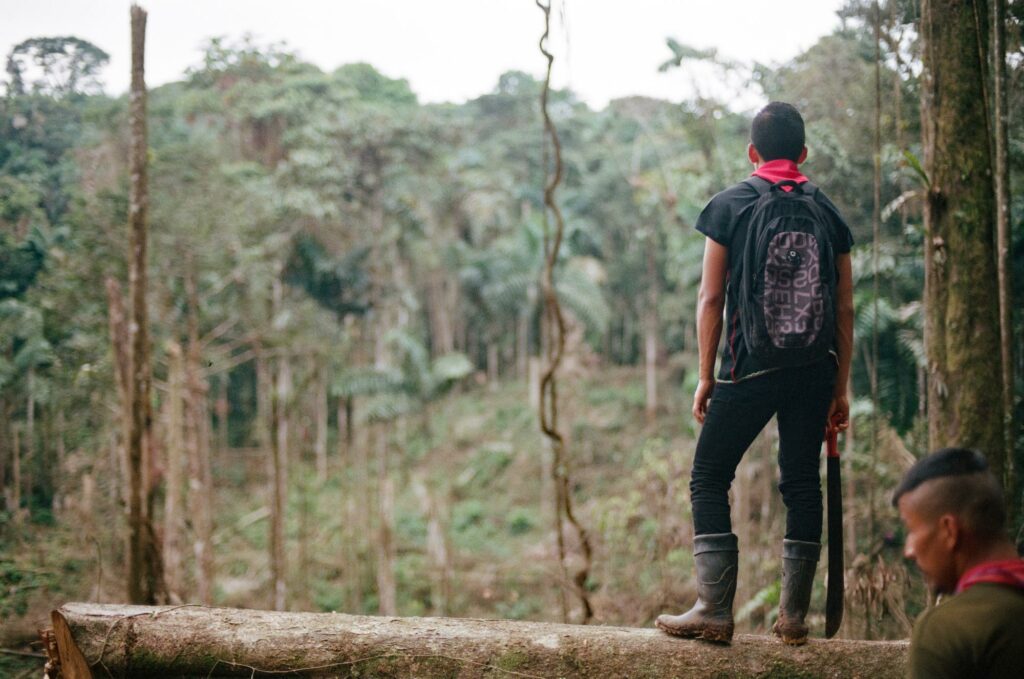
Deforestation in the Amazon Rainforest between 1985 and 2022: Here are the Hard Numbers and the Maps
Using information from the MapBiomas Amazonia Project, and Global Forest Watch, Amazon Frontlines’s Carlos Mazabanda compiled the following charts and maps showing the effects of deforestation and greenhouse gas emissions and capture in the Amazon as a whole and in Brazil, Colombia, Ecuador and Peru. The information shows the speed with which deforestation approaches the critical tipping point.
In the year 1985, 93.33% of the Amazon had natural vegetation cover; by 2022, 85,715,532.00 hectares of this cover was lost, an area the size of the entire Central American peninsula, Cuba, and Ecuador combined and representing an 11.20% overall loss of natural forest between 1985 and 2022 (Figure 1).
Figure 1. Natural and anthropic cover in the Amazon
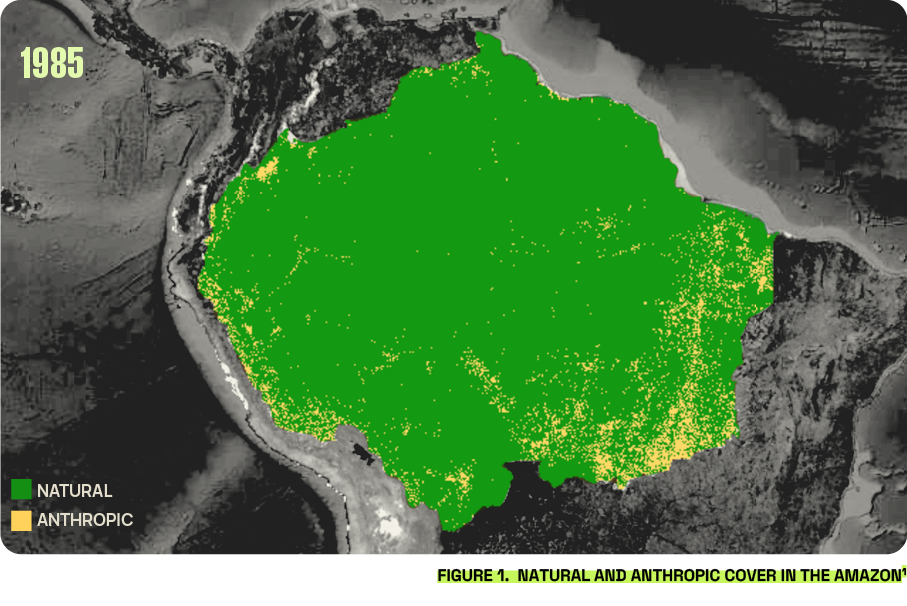
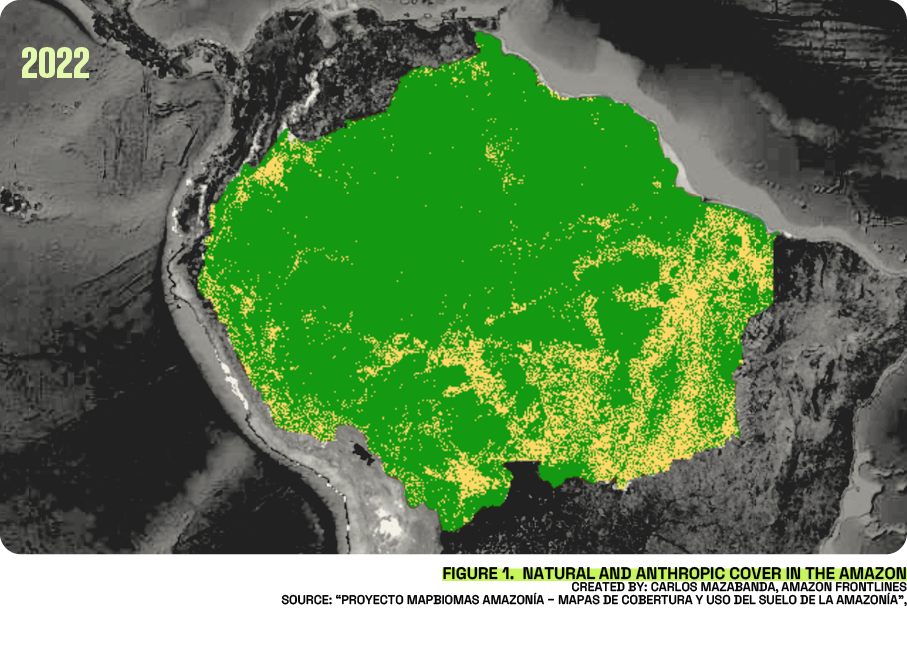
By 2022, 17.12% of the Amazon had been converted to anthropic use. Using the reference of the highest deforestation rate of the last 5 years in the Amazon biome (0.55%), we can predict a total loss of 25% of the natural vegetation cover within 14 years, that is, by the year 2036 (Table 1).
Table 1. Loss of natural cover between 1985 – 2022 and Tipping Point range estimate

Created by: Carlos Mazabanda, Amazon Frontlines – Source: “Proyecto MapBiomas Amazonía – Mapas de Cobertura y Uso del Suelo de la Amazonía”, via the link: https://amazonia.mapbiomas.org
As shown in Figure 1, the greatest disturbance in natural vegetation cover occurred in the Brazilian Amazon, which between 1985 – 2022 lost 71,130,032.00 hectares of cover, an area nearly the size of Chile and representing 82.98% of the total loss of natural forest throughout the Amazon in that period. The highest deforestation rate in the last 5 years is 0.69%, and at this rate, 25% of the natural forest of the Brazilian Amazon will disappear within 5 years (Table 1).
In the western part of the Amazon, Ecuador, Peru, and Colombia, together represent 18.89% of the total surface of the biome (Figure 2). Between 1985 and 2022, these 3 countries lost 6,673,161 hectares of natural Amazonian cover, an area twice the size of Belgium and equivalent to 12.27% of transformation to anthropic use by 2022 (Table 1).
Figure 2. Natural and anthropic cover in the western Amazon

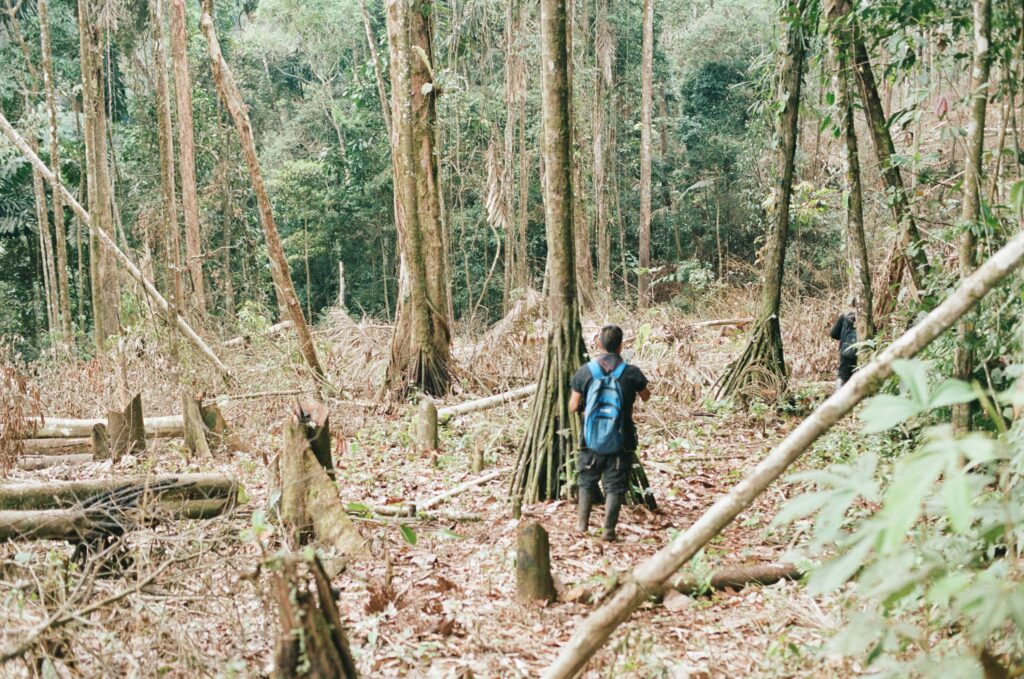
Deforestation in Indigenous territories
In the Amazon, Indigenous territories cover 236,587,282.50 hectares, an area larger than Mexico and representing 28.85% of the total surface of the biome. Between 1985 and 2022, 3,549,831.37 hectares of natural cover have been lost in these territories, which represents a loss of 1.53% over this period. In relation to the entire biome, the loss of natural cover in Indigenous territories represents 4.14%, that is, 95.86% of the area of loss of natural cover occurred outside Indigenous territories (Table 2).
Table 2. Loss of natural cover in Indigenous territories (IT)

Created by: Carlos Mazabanda, Amazon Frontlines
Source: “Proyecto MapBiomas Amazonía – Mapas de Cobertura y Uso del Suelo de la Amazonía”, via the link: https://amazonia.mapbiomas.org
An estimated 43.91% of the Amazon of Ecuador, Peru and Colombia are Indigenous territories. In these, 1,159,428.53 hectares of natural cover have been lost from 1985 to 2022, which is 1.79% of this area. This loss of natural cover in Indigenous territories represents 17.3% of the total affected area in the Amazon of the 3 countries (Table 2). We then have that 82.63% of the deforestation of natural cover in the Amazon of Colombia, Ecuador, and Peru occurred outside the limits of Indigenous territories.
Forest-related greenhouse gas emissions and sequestration (removals)

- Context by region and countries
The information shows the average annual emissions, sequestration (removals) and net flux of greenhouse gasses between forests and the atmosphere between 2001 and 2023. Emissions arise from disturbances that replace forest, while removals occur where forests were maintained or the forest expanded.
In the regional context of the Amazon, the value of greenhouse gas emissions from forest loss is very close to the value of sequestration or elimination, representing 96.14%. In other words, with an increase of 3.86% in emissions, the Amazon as a whole would no longer be a carbon sink.
Table 3. Greenhouse gas flows related to forests (Mtco₂e/year) in the Amazon between 2001 – 2023

Created by: Carlos Mazabanda, Amazon Frontlines. Source: Global Forest Watch
Bolivia and Brazil account for 85.98% of the total emissions in the entire Amazon and together they eliminate 72.41%. Thus, due to processes linked to deforestation in the Amazon of Bolivia and Brazil, emissions have exceeded the sequestration of greenhouse gasses, by 4.51% and 15.32%, respectively (Table 3). That is, in a general context, the Amazon within these countries has stopped being a carbon sink.
Peru, Ecuador, and Colombia account for 11.7% of the emissions and absorb 17.34% of the total emissions of the Amazon. Without taking into account Brazil and Bolivia, these three countries have a net emissions flow of -103 Mtco₂e/year (Table 3); With the data from Brazil and Bolivia, the net emission flow is 72.2 MtCo2 e/year. This indicates that forest degradation processes in Colombia, Ecuador, and Peru are not as aggressive as in Brazil and Bolivia.
Emissions with respect to absorptions in Colombia, Ecuador, and Peru are 61%, 64%, and 67%, respectively, so emissions would need to increase between 33% and 39% for the Amazon forests in order for these countries to lose the capacity to be carbon sinks (Table 3).
- Context in Indigenous territories of Colombia, Ecuador and Peru
Total emissions in the Indigenous territories of the Amazon in Colombia, Ecuador, and Peru are 41.29 MtCo₂e/year, which represents 21.29% of the total emissions of these countries and 2.50% of the total emissions of the biome. The removals or sequestration of greenhouse gasses are 130 MtCo₂e/year, which is equivalent to 43.67% of the total removals and 7.57% of the total emissions in the Amazon (Table 4).
Table 4. Flow of greenhouse gasses related to forests (Mtco₂e/year) in Indigenous territories of Colombia, Ecuador and Peru between 2001 – 2023

Created by: Carlos Mazabanda, Amazon Frontlines. Source: Global Forest Watch
Net eliminations in Indigenous territories total -88.71 Mtco₂e/year, which represents 85.46% of the total net emissions of Colombia, Ecuador, and Peru. In Indigenous territories, emissions are 31.76% of eliminations, that is, emissions would have to increase by 68.24% for these forests to stop being carbon sinks (Table 4).
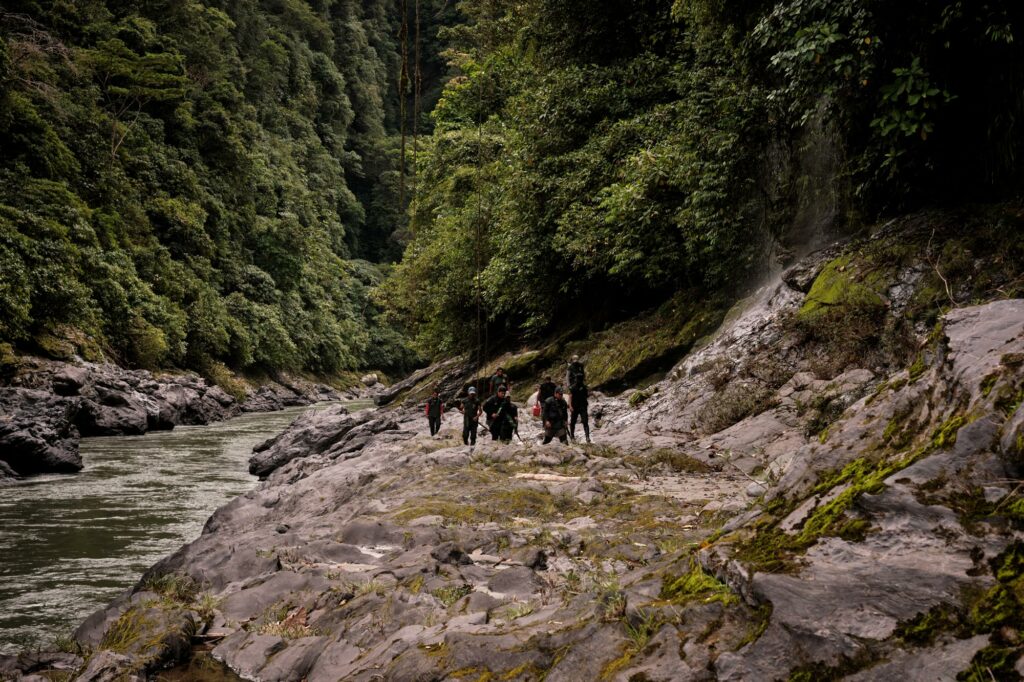
Indigenous Stewardship, Biodiversity, and Forest Health: Immediate and Viable Solutions
Indigenous peoples have lived in the Amazon rainforest for tens of thousands of years, as long as anywhere else in the Americans. Recent scientific studies debunk the colonial-era myth that Indigenous peoples simply killed animals for meat, dug up roots, and pulled fruit from trees to survive. Instead, and over thousands of years, millions of Indigenous peoples in the Amazon managed their landscapes, creating vast gardens, and showing that extensive human habitation and biodiversity can not only coexist, but thrive.
And then, over the last fifty years, between fifteen and twenty percent of the Amazon has been burned down, cut, poisoned and transformed by outsiders. It is no surprise then, that a number of recent studies have shown what Indigenous peoples have known all along: where they control their territories, the forests thrive.
In our contemporary world, control means property rights. And where Indigenous people hold collective property rights to their lands, there is less deforestation, lower carbon emissions and more secondary forest growth.
“Amazonian forests are home to more than 15,000 tree species, of which 1% are dominant and the other 99% are mostly rare. A single forest hectare in the central and northeastern Amazon can contain more than 300 tree species. Such tremendous tree species diversity can increase forest resilience by different mechanisms,”write the authors of “Critical transitions in the Amazon forest system.”
They continue: “Diverse forests are also more likely to resist severe disturbances owing to ‘response diversity’–that is, some species may die, while others persist. For instance, in the rainy western Amazon, drought-resistant species are rare but present within tree communities, implying that they could replace the dominant drought-sensitive species in a drier future.”
Those same intensely biodiverse regions of the Amazon are also culturally and linguistically diverse: “Amazonian regions with the highest linguistic diversity (a proxy for ecological knowledge diversity) are found in peripheral parts of the system, particularly in the north-west.”
The vital importance of the western, headwaters regions of the Amazon emphasizes the urgency of supporting Indigenous nations in their efforts to secure full property rights to their territories and thus ensure their protection and longevity.
“The immediate cessation of oil exploitation, mining, logging, and clearcutting in the Amazon rainforest is as urgently needed as it is immediately possible,” said Waorani leader and Amazon Frontlines co-founder Nemonte Nenquimo in a recent interview. Securing and supporting Indigenous land-titling and stewardship of their territories is essential to this immediately possible solution.
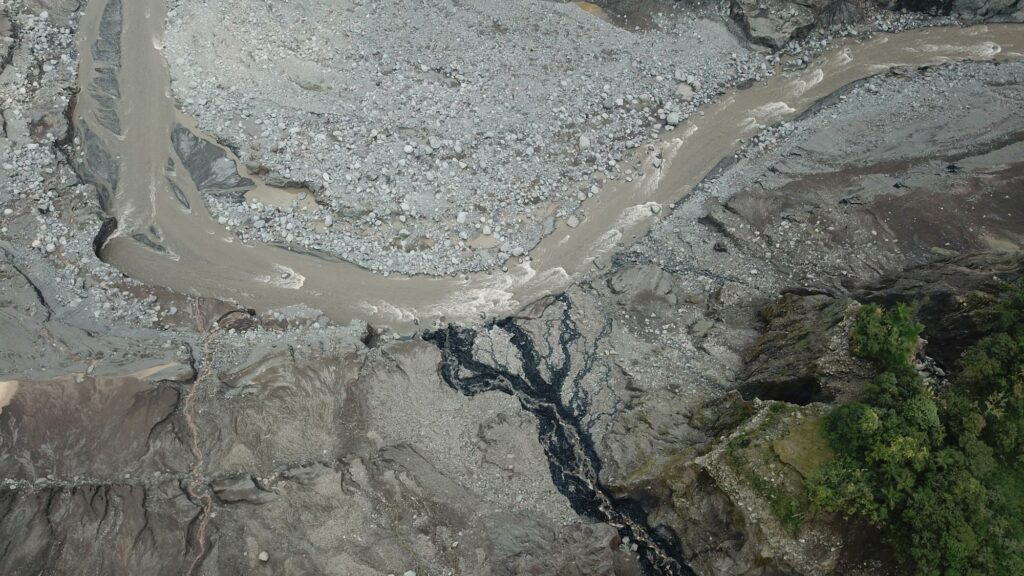
We’re not getting it: Stop Oil and Deforestation, Reduce Carbon Emissions, Title Indigenous Territories
Climate change is not provoked by carbon dioxide alone, though measuring CO₂ in the atmosphere is the standard for gauging the damage we’ve done, and the point beyond which we will unleash irreversible, catastrophic climate change. In 1959, the first time atmospheric CO₂ levels were recorded, there were 316 parts of carbon per million. By 1970: 325 parts per million. By 1990: 354. By the summer of 2005, then the most recent measurement available to reporter Elizabeth Kolbert: the level was at 378 parts per million.
In Field Notes from a Catastrophe, Kolbert wrote: “Many climate scientists now believe that 450 parts per million of CO₂ represents a more objective estimate of danger, while others argue that the threshold is 400 parts per million or even lower.”
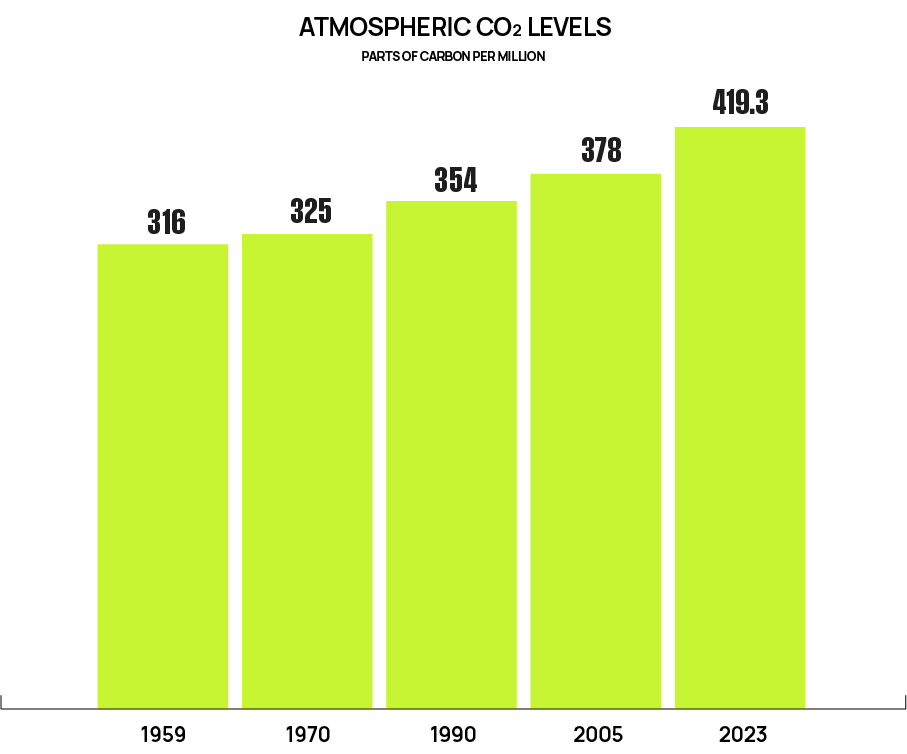
In 2023, scientists measured 419.3 parts per million of carbon dioxide in the earth’s atmosphere, a new record high.
We are not facing an impending crisis. We are already deep in the midst of it.
Bernard Flores, of the Federal University of Santa Catarina, Brazil and a lead author of “Critical transitions in the Amazon forest system,” recently told Jonathan Watts of The Guardian that “everything is happening now faster than we think. We need to address this with a very precautionary approach. We must reach net zero emissions and net zero deforestation as quickly as possible. It needs to be done now. If we lose the Amazon, it would be problematic for humanity.”
Problematic is an understatement, if not a euphemism. As this paper shows, if we don’t stop deforestation in the Amazon and if we don’t drastically reduce global carbon emissions, the Amazon rainforest will cross a tipping point, dry out, lose the ability to sustain itself, and begin an irreversible transformation into a vast savannah.
And yet, elected leaders, industry executives, and capital managers across the world refuse to see beyond their own political and economic interests. Their time horizons remain those of election cycles, quarterly earnings, and annual stockholder meetings. As the world literally burns, they seek to expand rather than transform fossil fuel economies.
Former Brazilian president Jair Bolsonaro promoted devastating and unprecedented mass deforestation in the Brazilian Amazon. Oil production grew to an all-time high under the Biden administration. Former US president Donald Trump now campaigns for reelection in 2024 shouting “drill, baby, drill!” In Ecuador, President Daniel Noboa, refuses to comply with the national referendum banning all oil extraction in the Yasuní National Park as he prepares to launch a new round of oil auctions in Indigenous territories.
And at the same time, citizens of the industrialized economies who largely reap the short-term benefits from the conveniences and hyper-consumerism of our current era must face the science: continuing the patterns of consumption we were taught to call everyday life in industrial societies will irredeemably alter the planet’s climate and push us all over the tipping points.
To address this crisis, Amazon Frontlines, together with our allies and partners, is fighting to stop oil production and deforestation while helping secure collective property rights for Indigenous territories in the biodiverse headwaters of the Amazon.
Our work seeks to contribute to a different feedback loop: by supporting Indigenous struggles for autonomy and cultural and territorial rights, we help protect the Amazon, and by doing so we simultaneously lessen the deforestation and carbon release that exacerbates climate change and global warming, which in turn helps further protect the Amazon from crossing the tipping point, which then further safeguards the vast and rich forests that more than three hundred Indigenous Nations call home.
We believe that this is what viable solutions look like in the Amazon: don’t clear-cut more forest for roads, don’t poison any more rivers with illegal mining, stop burning the forest to expand industrial soy and beef production, stop exploring and drilling for oil in the rainforest, conclude and clean up existing oil fields in protected areas and Indigenous territories, grant full legal title of ancestral territories to Indigenous Nations, and work together to support Indigenous political leadership globally and Indigenous stewardship of the most biodiverse forest on earth.
It is critical that the global community live within its means. Indigenous peoples, across the world and over thousands of years, have excelled precisely in this realm where industrialized societies have failed.
For, what the recent scientific studies show, is that even if we immediately stop deforestation across the region, the continued burning of fossil fuels worldwide will still push the Amazon–and the ice sheets and the permafrost and the boreal forests and the coral reefs–over the tipping point.
Every plastic bag, every new SUV on the road, every light switch powered by a coal plant, every load of bananas shipped across the ocean, every hectare of forest cut or burned, every hamburger, and every fast fashion t-shirt is connected to the burning world. We are all in this together, which means that we can work together to imagine not only a sustainable future, but an exciting and beautiful one. We need the courage to imagine, and then we need the courage to act.
Several years ago the Indigenous artist, Cannupa Hanska Luger, launched a project called Future Ancestral Technologies. Indigenous author Ailton Krenak recently published a book called Ancestral Futures. Both echo a phrase, and an idea, that has been circulating in Indigenous communities for some time: the future will be ancestral.
A 2023 article in Science, “Intentional creation of carbon-rich dark earth soils in the Amazon,” shows that Indigenous peoples in the Amazon “managed soil to improve fertility and increase crop productivity” over thousands of years. Their practices also “sequestered and stored carbon in the soil for centuries.” Future ancestral technologies: humanity already has the knowledge necessary to address and mitigate the climate crisis. And the Indigenous peoples of the Amazon are on the frontlines of this global struggle.

